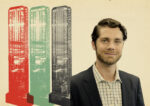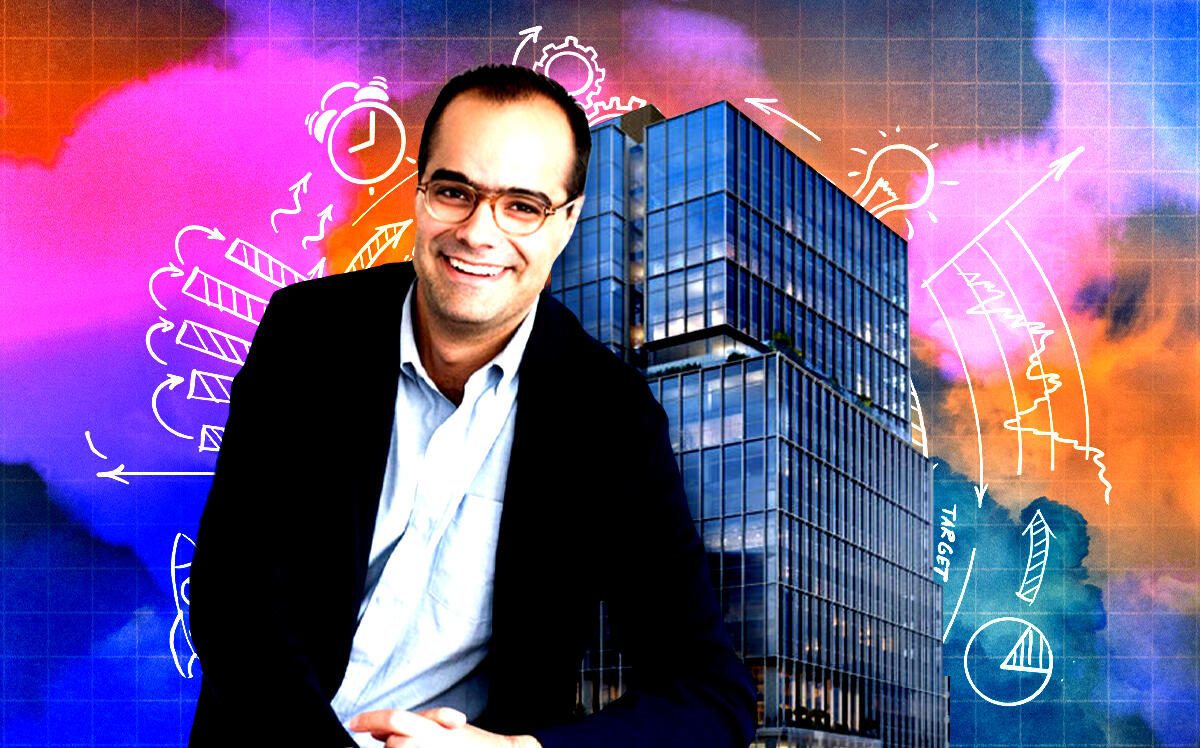Everything’s bigger in Texas, but Kohn Pedersen Fox can do big.
As the architect behind dozens of attention-grabbing projects across the world, including Hudson Yards and One Vanderbilt in Manhattan and One Bayfront Plaza in Miami, KPF can skyscrape and master-plan with the best. In recent years, it has turned its attention to Texas.
In Austin, the firm designed Waterline, a 2.7 million-square-foot tower with 350 apartments, as well as a One Hotel and office space. Once it’s finished, Waterline will be 1,022 feet tall, making it the tallest building in Texas. Just across the river, KPF designed One Lady Bird Lake, one of the Related Companies’ first projects in the city as it assembles something of a company town near South Congress.
The firm is also behind an innovative “upside down” office project in Dallas’ fast-growing Uptown district and an 11-acre master-planned district along the Katy Trail.
Forth Bagley, a principal with KPF, is leading each of these projects as Texas’ cities experience unprecedented growth and investment. As the next phases of Texas skylines are drawn, in some of the most exciting cases, Bagley is holding the pen.
The Real Deal visited Bagley at KPF’s office in New York to talk about whether the flight to quality is real, why he views Texas like Europe, and how he came to grips with designing the tallest tower in Texas.
TRD
Let’s start with Parkside Uptown in Dallas. It is a textbook Class A+ building. There’s a sky lobby and greenery everywhere, amenities through the roof. What do you make of the “flight-to-quality” that we’re all hearing about? Has that changed the way that you’re approaching office design?
Forth Bagley
The pandemic hasn’t created new trends; it’s just sped up trends that were already gestating. So this hybridization of office lobbies looking like hotel lobbies, like that image there [points to a rendering pinned to his wall], if I told you five years ago that that was an office lobby, you wouldn’t believe it. You’d say, “No, it’s a hotel lobby,” or something. But that trend was already gestating in pre-Covid, and the pandemic just supercharged it.
In San Francisco, we were designing an office building where there’s a tiny lobby, and it’s mostly just a cafe, so it’s like entering through a coffee shop. Now we’re seeing that in our buildings in Hong Kong — it’s a global phenomenon. Because of the internet of design, or design through the internet, everyone has a picture of what hospitality is that they get from Instagram or whatever, and it is ubiquitous. It flows to all these markets.
Parkside Uptown was designed pre-Covid. The thing that’s interesting about Parkside is, it’s basically situated at Main and Main. It’s the best location in Dallas. The site sells itself. So the question is, what do you do in the building to amplify the pride of place? A lot of the conversations had to do with indoor-outdoor spaces and emphasizing the relationship to Klyde Warren Park.
It’s a super tight site, so how do you get cars in and out? At the end of the day, when you’re flushing people out of the building, how do you make it convenient to suburban tenants? So hence, the sky lobby, so you’re not going down to go up. It’s designed inside out, but in a way that’s very specific to its place and the primacy of that site in particular.
“How we've approached Texas as a market is — this is going to sound totally bizarre — almost like Europe”
Forth Bagley
TRD
Speaking of parking — transit and traffic has become a hot-button issue in Austin. And Texan cities are far more car-dependent than, say New York. How has Texas’ approach to transportation changed your approach to design?
Forth Bagley
Well, New York is a special case. In Hudson Yards, there’s like 15 spaces — it’s totally different. How we’ve approached Texas as a market is — this is going to sound totally bizarre — almost like Europe.
TRD
Go on.
Forth Bagley
Paris is a different market than Berlin; Berlin is a different market than Milan; and Milan is totally different than London. Everyone gets it when you talk about Europe, but when you talk about Texas, people think it’s just one state. They treat it like a country. But the Austin market is a very different market than the Dallas market, which is a very different market than the Houston market. If you treat them like city states, and you respect the differences in the market, and react and adjust your business delivery, your design delivery, your actual delivery, what scope you take on, try to highlight the specific markets, you create very different buildings in each city.
That said, the parking is not much different. We work in a lot of places where there are parking minimums, and even in Austin, which has pretty progressive planning, where there are view corridors, things we encounter in Boston or in London at a planning zoning level, the parking is still the thing that drives the design. So despite all those great progressive planning efforts, they still have these parking requirements that are really onerous. They drive the creation of these huge podiums, which affect the building typologies.
So in that respect, Waterline’s parking podium is very similar to a parking podium in Dallas and the parking podiums within Houston. There is that commonality between those markets, but with the exception of that parking issue, I find the markets totally different.
TRD
Can you expand on those differences? Like, what makes designing for Austin different than designing for Dallas?
Forth Bagley
The Austin market is driven by this ongoing building boom. Before this particular building boom, it’s a capital city. It’s a college town. It’s got indigenous innovation businesses that come out of a combination of being a capital and a university town, like a supercharged version of Madison, Wisconsin. Now, with this latest building boom, they’re getting a lot of the benefits of West Coast tech companies fleeing for tax reasons, for flight-to-livability for their employees.
But the people that are going to Austin are very different to people going to Dallas. I had a client in Dallas, who will remain nameless, who said that he approaches every development remembering that there’s no reason for Dallas to exist. It’s an anomaly. It’s in the middle of nowhere, it’s not really connected through any kind of river transportation. There’s no reason for it to exist, other than that it has created the conditions for business to thrive.
It has a world-class international airport; it’s business friendly; it’s a great place to raise families; it’s affordable because of the expansion. The development patter there is they build residential, build office, and they get flight to these new businesses and new houses. Then they go to the next community, and they do it again. The jump stop of development creates conditions for livability, affordability and business-friendly environments, which attracts banks, global back-of-house businesses, and front-of-house now too, and talent.
When we go through approval processes, the approval processes in Austin are onerous. They’re more like the approval processes we see in mature cities with institutions like world-class universities and state governments. In Dallas, they also have processes for approval. I think they are onerous, and they’re challenging, but they’re pro-business. They understand the conditions that allow for development, and they allow for development to occur in a much more logical, much more pro-business way than in Austin.
And then, our experiences in San Antonio are very different from Houston, very different from Austin. In some cases, San Antonio is drafting off Austin, but it’s also a national tourist destination.
I was in Orlando the other day and talking to the planners there. Orlando has much more in common with San Antonio than either of those cities would admit. And probably more in common with each other than it does with Austin just down the street, because there are these huge influxes of tourists.
Everyone knows Alamo, everyone from this country goes there at some point. So the drivers of those projects that we’re working on are more hospitality focused, more leisure focused, more lifestyle focused than either Austin or Dallas.
TRD
I’d like to talk about the One Ladybird project. What’s the difference between working with a national developer like Related and one with more of a local presence in Texas, say Kairoi Residential on Waterline?
Forth Bagley
I think they faced many of the same things we’ve faced when we first went down to Texas, which was like, “Oh, here come the Yankees. They’re not going to understand the way we work and the culture.” And I think they’re working hard to overcome that and bring a type of office environment that doesn’t exist in the market. They recognize the difference and view it as a place where they can create market differentiation.
We’ve done a lot of buildings for Related. We went through all the battles of Hudson Yards together, we’re designing an office building in Boston for them, one in Chicago for them, Palm Beach for them, and in California for them. So our work with them has also tracked their own expansion from a New York developer to a national developer. So we have all the good and bad habits that are accumulated working with repeat clients in Austin.
It’s very different from working for someone who only has developed in Austin, over and over again. When we worked with Kairoi on Waterline, there’s an indigenous knowledge of the market that is so ingrained in every decision that they make, because they are the industry leader in that sector and that city. They are the market — they created the market and produced its standards.
It’s totally different than when you’re working with a developer that’s looking at the market and saying, “Wait a second. Why do they do that in Austin? Why are the closets so big in Houston?” There are all these weird things that, when you’re an outside developer or architect, you look at, and you’re like, “Wait a second, that closet is enormous.”
TRD
Is that true? Closets are bigger in Houston?
Forth Bagley
They’re bigger than apartments in New York City.
TRD
I didn’t know about that.
Forth Bagley
Working with both national and regional developers has made us better. It’s also made us really attuned to the cultural differences between the cities. The biggest lesson that we learned in Texas is just that they’re not the same. Which obviously sounds stupid, but if you approach them like Europe, you start to understand the differences.
TRD
When did KPF start this new focus on Texas?
Forth Bagley
I think it’s unclear if we found Texas or Texas found us.
For a long time, commercial architecture was seen as a four letter word by fancy architects. I think we changed that in the ’80s, ’90s, 2000s. Our basic premise was, “We’re elevating the basic building blocks of the city,” which, eight times out of 10 was an office building or a residential building. So we took that as our mission for the firm.
I also think there was a maturing of the urban environments in these Texas cities, places like Austin and Dallas. Houston, where people were wanting to live in the cities and demanding better from the market. So we were starting to look and say, “Wait a second. That’s a KPF project. Why aren’t we considering that? We could have taken that project and made it really special.”
We started focusing on it and spending time down there. And you get one project, you’re down there, you meet other people, and you start to build up knowledge and experience.
The other thing was, up until the last five years, the model was always like, “If you hire a New York architect, they take minimal scope. You pair them with a local architect, and they give you some concept design sketches, and then you tell them to go away, and your local guy finishes the building for you, and everyone’s happy.”
We’ve seen a change in the market where, off the back of projects like Hudson Yards and One Vanderbilt, our capability as a “New York architect” for full-service delivery is pretty high, actually. So when we went with Related to Ladybird Lake, it was like, “Of course KPF can do the whole building. Why would we not?”
Out of all the states in the United States and all the countries in the world, some of our most innovative, interesting projects are in Texas. We’re competing against other places — when we do a building in Austin, we’re competing against Music Lane and Rainey Street and all these other places in Austin — but we’re also competing against time.
When we started Hudson Yards, the iPhone hadn’t been invented. You just think of the transition, the technological advances, that took place between the time that plan was started and the time the building was finished. Not just the distraction of the phone, having every piece of information available at your fingertips, but being able to call a ride without worrying about your safety, or delay or anything. All those innovations are being brought to bear with these technologies in your hand, so your buildings have to do so much more to distract you and to get you to come back to a building, when you can just disappear into the internet for hours. So what you have to do as an architect is not just compete against other architects and other developers, but you’re competing for people’s time, which is our most valuable commodity.
And then, I found that if you create places that people who live in Austin want to go to, and people who live in Dallas want to go, that the rest of the stuff takes care of itself. Because if it feels authentic to someone who is authentically from Austin or authentically from Houston, it will feel amazing to someone who’s coming in from New York or Los Angeles.
“When we do a building in Austin, we're competing against Music Lane and Rainey Street and all these other places in Austin — but we're also competing against time.”
Forth Bagley
TRD
KPF designed Waterline, which is set to become the tallest building in Texas, at least before someone else takes the crown. How did you look at that responsibility?
Forth Bagley
Honestly, I don’t think we knew. Talking to the team the other day, I don’t think any of us really realized that it was the tallest building until we started doing press for it, and then we were like, “Oh.”
We were so paranoid about Rainey Street. “How do you create this much density next to a bungalow? How do you mediate these densities?” And we were talking about parking garages earlier — just the requirement of putting the parking there, whatever it is, 10, 12 stories up, instantly blows the scale of Rainey Street. There’s nothing you can do with parking. No amount of materiality and shielding will do that, so we felt like we had to do that through the programming of the spaces.
And we were lucky on that project. We had the conditions there for the perfect lifestyle mixed-use project. We were really focused on the program and materiality more than the shape of the building or anything like that, because we were so paranoid about destroying Rainey Street. And I think we were right. I still worry about Rainey Street.
It’s weird in that environment, where you have this progressive planning, and you have even developers who see that value and don’t want to destroy it. And there’s nothing you can do once the train starts moving. All you can do is try to make sure it’s moving responsibly, and you’re creating a place that people want to be in. I think it’s okay that it changes. Cities change over time. It’s okay to not memorialize one-story bungalows, because actually, that’s not what cities are about. They’re not about freezing time. But you also want to make sure that in these generations, you’re building up these densities, and you still have a neighborhood that’s recognizable and enjoyable and joyful. That was where the materiality and the playfulness of the program was really important to us. We were really not focused on height, I don’t know, for better or worse.
Read more


